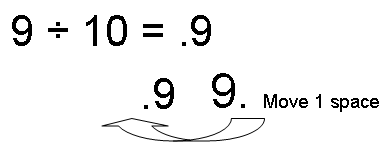GEAR UP FOR LIFE
MATH MENTOR: The Metric
System of Ten's
The metric system is used all over the world. If you are American or British, you will have to learn to convert measurements from the English system to the metric system.
Working with Ten's
If you know how to add, multiply and divide by ten, you will not have any trouble with the metric system. It is based on measurements of 10.
When you multiply or divide by ten, or multiples of ten (10, 100, 1,000, 10,000, 100,000, etc...), all do is move the decimal point to the right or to the left.
Keep in mind that every whole number has a decimal point. All numbers to the left (<-) of the decimal point are whole numbers. All numbers to the right (->) of a decimal point, are fractions or parts of a whole number.
![]()
Whole numbers do not show their decimal points. That's because the decimal point always comes after the whole number. There is no reason to write it. The number 6 can be written as 6 or 6.0. It's easier to write 6.
14 = 14.0 7 = 7.0 65 = 65.0 134 = 134.0
MULTIPLY BY TENs
If you multiply a whole number by 10, you would just move the imaginary decimal point one space to the right (=>).
10 X10 = 100 (100.0)
20 X 10 = 200 (200.0)
175 X 10 = 1750 (1,750.0)
If you multiply a whole number by any multiple of 10, just count the zero's and move the imaginary decimal point that many spaces to the right.

10 X100 = 1000 (10,00.0)
20 X 1000 = 20000 (20,000.0)
175 X 10,000 = 175,000 (175,000.0)
DIVIDE BY TENs
Division is just the opposite of multiplication! That means that you move the decimal point to the LEFT when you divide by 10 or multiples of 10.
If you divide 10 ÷10, you would move the decimal point to the left (<=). You would have 1.0, or one one
10 ÷ 10 = 1 (1.0)


[NOTE: COUNT THE ZERO'S. Then MULTIPLY (-->) TO THE RIGHT; DIVIDE (<--) TO THE LEFT.]
The same process applies to numbers that are not whole. They have fractions or parts of a whole in the number.
Think of a dollar -> $1.00 (Notice that the decimal point is after the 1.
If I have 1 dollar ($1.00) and half of a dollar (a part), I have $ 1.50 (notice that the .50 represents only part of a dollar, so it goes to the right of the decimal point).
If I multiply 1.50 by 10, I'll have 15.00! I moved the decimal point over by 1 zero.
If I earn $ 7.65 an hour, and I've worked 10 days, how much does my company owe me?
$ 7.65 X 10 = $ 76.50
Move the decimal point over by one.
Now we can talk about the METRIC SYSTEM of measuring. In the English system, we measure in inches, feet, yards and miles. The metric system uses different terms.
METER (m): the basic unit of the metric system. It uses the Earth as its measuring stick. One meter is said to be one ten-millionth of the distance from the Equator to the North Pole.

CLICK the Mentor Icon to go to measuring distance with
the metric system
